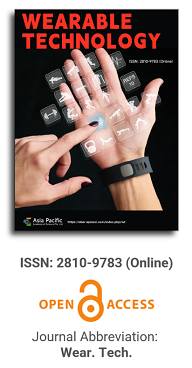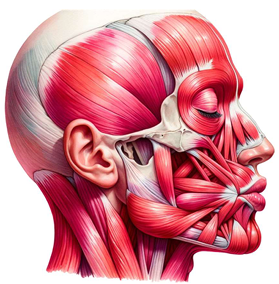

This paper delves deeply into the innovative realm of integrating human emotions with wearable technology. The primary focus is on the conceptualization and development of a kiss transfer device that harnesses the power of wearable technology to bridge the physical gap in human-human interactions. By investigating the intricate nuances of the human-human kissing process, the research seeks to replicate this intimate gesture through a technological medium. The paper not only elaborates on the anatomy, evolution, and hormonal dynamics of kissing but also underscores the transformative potential of wearable technology in capturing and transmitting these intimate moments. This exploration opens up new horizons for long-distance relationships, offering a tangible touchpoint that goes beyond traditional communication methods. Through this pioneering work, the research positions wearable technology as not just a tool for communication but as an extension of our human emotions and expressions.

Full Issue
| View or download the full issue |
Implants are medical devices designed and manufactured to enhance an existing biological structure, support a damaged biological structure, or even replace a missing biological structure. They are extensively used in surgery all around our bodies, such as limbs, ears, mouth, etc.
Prof. Kátia de Freitas Alvarenga from São Paulo University located in Brazil was invited to write an implant-related article for Wearable Technology. Her team showed us a story about the function of cochlear implant in hearing impairment caused by Kearns-Sayre syndrome (KSS). The effects of AASI (a kind of individual sound amplification devices) were compared in a pair of twin sisters.
Oral implants, calcaneo-stop implants and pacemakers related research were also collected in this issue. Implants research in English speaking developed countries are spread all over the world. Here, we hope to help researchers know more about the implant-related research situation in Spanish speaking countries.
Managing Editor
Dr. Yina Xu
Introduction: In recent years, the placement frequency of permanent pacemakers has increased due to some risk factors, some of which are carried out through cables. Objective: To determine the prevalence and related factors of permanent pacemaker implantation in adult patients in the cardiology department of José Calasco Artega hospital in 2017. Methods: a randomized cross–sectional study was conducted on 422 patients over 18 years old in the cardiology department of “José Carrasco Arteaga” hospital in Cuenca, Ecuador from January to December 2017. Information is processed in SPSS software version 24. Descriptive statistical analysis based on frequency and percentage was used to measure the statistical correlation with odds ratio (or) within 95% confidence interval. When p<0.05, it was considered to be statistically significant. Results: The implantation rate of cardiac pacemaker was 7.1%, and the average age was 65.52 years (DS±14.77), mainly male. The risk factors associated with pacemaker implantation were atrioventricular block or 42.56 (95% confidence interval: 16.06–112.73, p=0.000); Sinoatrial node disease or 59.34 (95% CI: 11.67–301.93, P=0.000) and others or 0.017 (95% confidence interval: 0.00–0.05, p=0.000). Atrial fibrillation was not statistically significant or 1.71 (95% confidence interval: 0.62–4.71, p=0.354). Conclusion: The prevalence of pacemaker implantation is 7.1%, which is related to atrioventricular block, which is the main risk factor, followed by nodular diseases.
Introduction: In Colombia, the latest oral health study shows that about 70% of the population suffer from partial edentulism, while 5.2% lose all teeth between the ages of 65 and 79. Implant rehabilitation is an increasingly and widely used option, which requires clinical and X-ray follow-up. Panoramic X-ray examination is a low-cost option. In this case, the area of bone loss, the middle and distal angle of the implant, the relationship with the anatomical structure and the related lesions of periimplant inflammation can be observed. Data on X-ray findings associated with dental implants need to be reported and analyzed to determine risk factors for success in patients using these implants. Objective: To determine the prevalence and characteristics of findings related to osseointegrated implants in panoramic X-ray films. Methods: Descriptive cross-sectional observation was used to select 10,000 digital panoramic photos from the radiation center in Bogota, Colombia, of which 543 were related to the presence of implants. The position, angle and distance from adjacent structures of each implant were evaluated using program ClínicalView® (Orthopantomograph OP200D, Instrumentarium, USA). Result: The X-ray frequency of implants was 5.43%. There were 1,791 implants, with an average of 3.2 X-rays per time. They have a higher proportion in the maxilla and are located on the crest at an angle of 10.3 degrees. 32% of patients had implant/tooth or implant/implant distance below the optimal value. 40.9% of the patients were repaired, and 1.2% of the patients had periodontitis. Conclusion: The high proportion of modified implants has a risk factor that affects their long-term survival, whether due to angle, ridge or ridge location, adjacent teeth or other implants, or because they are irreparable.
One of the correction methods of children’s flat foot is calcaneal insertion. The purpose of this work is to determine the performance of calcaneal stop by using two bioco MPatible materials. The Finite Element Method (FEM) is used. The material analysis is AISI 316L steel and Ti-6Al-4V titanium alloy. Using Cuban anthropometric models, loads were calculated based on foot biomechanics and body weight of boys and girls aged 10 and 12. The results show that the implant model ensures the mechanical strength of the two materials. The difference between the two stresses is 4.44 MPa, accounting for 5% of the difference. Both materials have sufficient mechanical strength reserves because the maximum stress is less than the elastic limit of the material and ensures the mechanical strength of the calcaneal stop design.
Otolaryngologists engaged in cochlear implant surgery are very careful to require a variety of complex medical and clinical examinations in order to make a clear diagnosis and perform surgery to improve hearing and speaking. From a biomedical point of view, this is not controversial. However, in the analysis, if the personal, social, family and environmental factors of deaf people are not considered as important as pathology, the wanted results may be undermined. This reflective article highlights these situations, which are part of the bioethics view and considered to be a necessary supplement to the rehabilitation of deafness. The dilemma and conflict in bioethics are defined so as to put the pathology of deafness, the deaf and their environment in the framework of the concept of overall health and the doctors’ responsibility, then to reach the bioethics principles of Beauchamp and Childress. Its purpose is to show that cochlear implantation can be attributed to a valuable cutting-edge technology operation behavior, and the prejudices and values of this medical technology must be surpassed and understood, which directly or indirectly, positively or negatively affect the deaf.
Introduction: The use of in vitro implants can repair severe resorption. This sometimes requires the use of prostheses in the most extreme cases, when the proportion of crown implants is not ideal, to reach 2:1 or 3:1. Materials and methods: clinical analysis was carried out on implants with a residual of 5.5mm or less and more than 6 months. Chi square test was used for categorical variables and student t–test was used for continuous variables. Then, a linear fitting regression model is established. Results: Six patients received in vitro implantation. 21.2% of the patients in the study were male and 78.8% were female, with an average age of 57 years. The average crown planting ratio was 3.19 (+/–0.24). The average bone loss of the implant was 0.86mm (+/–0.33) in the near median position and 0.83mm (+/–0.47) in the anterior position. There was no statistically significant difference in the functional proportion of proximal and distal bone loss (P=0.224). Conclusion: According to the data provided in this study, even if the crown implant.
Hearing loss may be related to several factors, including hearing loss resulting from certain genetic syndromes. Kearns-Sayre syndrome is characterized by mutations in mitochondrial DNA (deoxyribonucleic acid), responsible for the production of energy (adenosine triphosphate-ATP), which is extremely important for the development of structures that require it, such as the cochlea. The case was followed up at the hospital since 2000, due to the progressive characteristic of hearing loss found in audiological tests and findings in cases related to the syndrome. The intervention with individual sound amplification devices proved to be of little benefit for good oral communication of one of the patients, who was diagnosed with bilateral profound hearing loss. Thus, after discussions in clinical meetings, the team opted for the indication of the cochlear implant for the patient, according to the current criteria for indication of this surgery, and with which it obtained good results. His twin sister, who presented good results with hearing aids, will continue in audiological follow-up, to verify the evolution of the case and discuss a new approach, if necessary. Patients with suspected or diagnosed Kearns-Sayre syndrome should seek audiological diagnosis, because it is a possible progressive hearing loss, requiring rehabilitation with the use of hearing devices. Maintaining oral communication is extremely important because, in these cases, other functions will be impaired, such as muscle tone and vision.

Prof. Zhen Cao
College of Information Science & Electronic Engineering, Zhejiang University
China, China
Processing Speed
-
-
-
- <5 days from submission to initial review decision;
- 62% acceptance rate
-
-
Asia Pacific Academy of Science Pte. Ltd. (APACSCI) specializes in international journal publishing. APACSCI adopts the open access publishing model and provides an important communication bridge for academic groups whose interest fields include engineering, technology, medicine, computer, mathematics, agriculture and forestry, and environment.


 Open Access
Open Access



